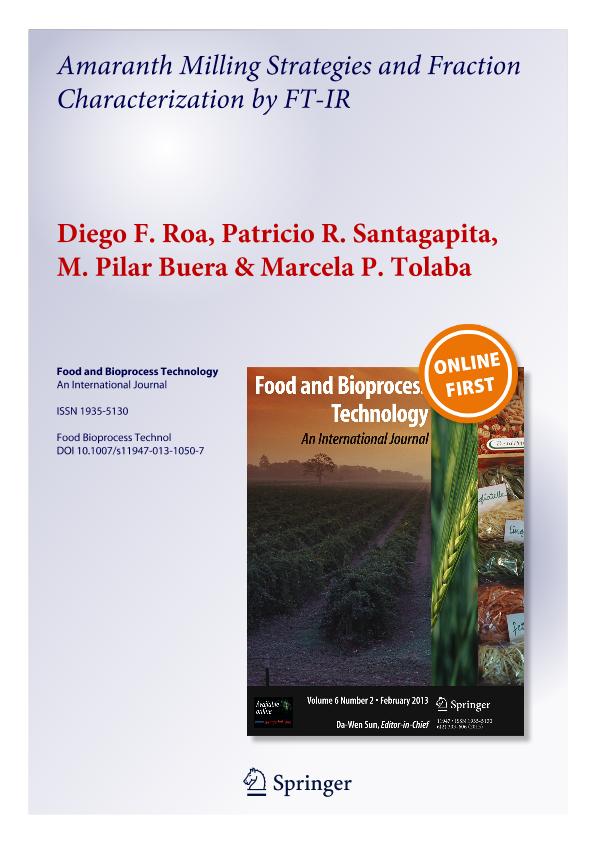Mostrar el registro sencillo del ítem
dc.contributor.author
Roa Acosta, Diego Fernando

dc.contributor.author
Santagapita, Patricio Roman

dc.contributor.author
Buera, Maria del Pilar

dc.contributor.author
Tolaba, Marcela Patricia

dc.date.available
2019-08-30T23:48:26Z
dc.date.issued
2014-03
dc.identifier.citation
Roa Acosta, Diego Fernando; Santagapita, Patricio Roman; Buera, Maria del Pilar; Tolaba, Marcela Patricia; Amaranth Milling Strategies and Fraction Characterization by FT-IR; Springer; Food and Bioprocess Technology; 7; 3; 3-2014; 711-718
dc.identifier.issn
1935-5130
dc.identifier.uri
http://hdl.handle.net/11336/82687
dc.description.abstract
Amaranth nutritional value has been widely recognized, but the required conditions for its processing cannot be adapted to traditional technologies. For the proposal of alternative strategies, the changes of several components should be understood. Enriched starch and lipid-protein fractions of amaranth flour upon different milling treatments were obtained and characterized by attenuated total reflectance-Fourier transform-infrared spectroscopy. Starch- and lipid-protein-enriched amaranth fractions were obtained by abrasive milling; amaranth starch was isolated by wet-milling procedure, and flour samples were obtained from planetary ball milling. Changes on starch, protein, and lipids relative contents, on starch crystallinity and on lipids and protein stability after milling and 6-month storage, were evaluated. The Fourier transform-infrared (FT-IR) spectroscopy peaks of the main grain components were identified in the middle-infrared range. By calculating the ratios between height intensities of selected specific peaks, several characteristics of the samples could be explained: increased protein content and lipid proportion of the enriched fraction; decrease of the starch crystallinity degree by abrasive milling and especially by ball milling due to starch amorphization during these processes; and lipids modification in milled and in 6-month aged samples. FT-IR analysis can be considered a rapid, nondestructive, solvent-free, sensitive, and useful tool to investigate starch, lipid, and protein modifications provoked by processing and storage as well as to determine, based on intensity ratio, the relative proportion of grain components within amaranth milling fractions. The abrasive milling associated to planetary ball milling to obtain modified different fractions is presented as an interesting strategy for the processing of amaranth grain.
dc.format
application/pdf
dc.language.iso
eng
dc.publisher
Springer

dc.rights
info:eu-repo/semantics/openAccess
dc.rights.uri
https://creativecommons.org/licenses/by-nc-sa/2.5/ar/
dc.subject
Abrasive Milling
dc.subject
Amaranth
dc.subject
Ball Milling
dc.subject
Ft-Ir
dc.subject
Lipid-Protein Fraction
dc.subject
Starch
dc.subject.classification
Alimentos y Bebidas

dc.subject.classification
Otras Ingenierías y Tecnologías

dc.subject.classification
INGENIERÍAS Y TECNOLOGÍAS

dc.title
Amaranth Milling Strategies and Fraction Characterization by FT-IR
dc.type
info:eu-repo/semantics/article
dc.type
info:ar-repo/semantics/artículo
dc.type
info:eu-repo/semantics/publishedVersion
dc.date.updated
2019-06-26T13:28:55Z
dc.journal.volume
7
dc.journal.number
3
dc.journal.pagination
711-718
dc.journal.pais
Alemania

dc.journal.ciudad
Berlin
dc.description.fil
Fil: Roa Acosta, Diego Fernando. Universidad de Buenos Aires. Facultad de Ciencias Exactas y Naturales. Departamento de Industrias; Argentina. Consejo Nacional de Investigaciones Científicas y Técnicas; Argentina
dc.description.fil
Fil: Santagapita, Patricio Roman. Universidad de Buenos Aires. Facultad de Ciencias Exactas y Naturales. Departamento de Industrias; Argentina. Consejo Nacional de Investigaciones Científicas y Técnicas; Argentina
dc.description.fil
Fil: Buera, Maria del Pilar. Universidad de Buenos Aires. Facultad de Ciencias Exactas y Naturales. Departamento de Industrias; Argentina. Consejo Nacional de Investigaciones Científicas y Técnicas; Argentina
dc.description.fil
Fil: Tolaba, Marcela Patricia. Universidad de Buenos Aires. Facultad de Ciencias Exactas y Naturales. Departamento de Industrias; Argentina. Consejo Nacional de Investigaciones Científicas y Técnicas; Argentina
dc.journal.title
Food and Bioprocess Technology

dc.relation.alternativeid
info:eu-repo/semantics/altIdentifier/url/http://link.springer.com/article/10.1007%2Fs11947-013-1050-7
dc.relation.alternativeid
info:eu-repo/semantics/altIdentifier/doi/http://dx.doi.org/10.1007/s11947-013-1050-7
Archivos asociados
